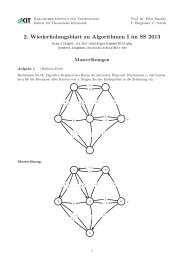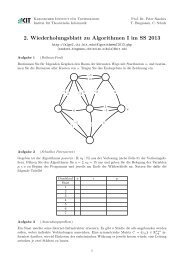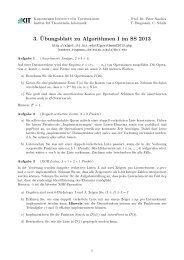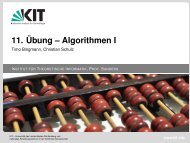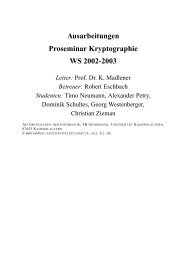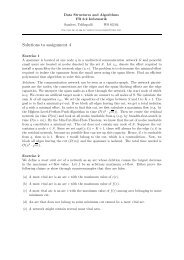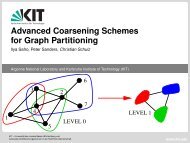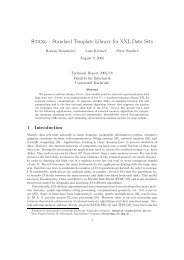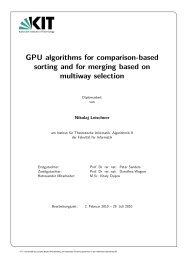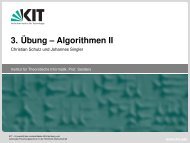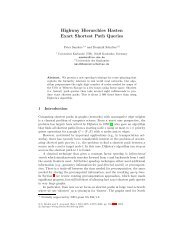LNCS 3142 - The Power of Verification for One-Parameter Agents
LNCS 3142 - The Power of Verification for One-Parameter Agents
LNCS 3142 - The Power of Verification for One-Parameter Agents
You also want an ePaper? Increase the reach of your titles
YUMPU automatically turns print PDFs into web optimized ePapers that Google loves.
<strong>The</strong> <strong>Power</strong> <strong>of</strong> <strong>Verification</strong> <strong>for</strong> <strong>One</strong>-<strong>Parameter</strong><br />
<strong>Agents</strong> ⋆<br />
Vincenzo Auletta, Roberto De Prisco, Paolo Penna, and Giuseppe Persiano<br />
Dipartimento di In<strong>for</strong>matica ed Applicazioni “R.M. Capocelli”, Università di Salerno,<br />
via S. Allende 2, I-84081 Baronissi (SA), Italy.<br />
{auletta,robdep,penna,giuper}@dia.unisa.it<br />
Abstract. We study combinatorial optimization problems involving<br />
one-parameter selfish agents considered by Archer and Tardos [FOCS<br />
2001]. In particular, we show that, if agents can lie in one direction<br />
(that is they either overbid or underbid) then any (polynomial-time) capproximation<br />
algorithm, <strong>for</strong> the optimization problem without selfish<br />
agents, can be turned into a (polynomial-time) c(1 + ɛ)-approximation<br />
truthful mechanism, <strong>for</strong> any ɛ>0. We then look at the Q||Cmax problem<br />
in the case <strong>of</strong> agents owning machines <strong>of</strong> different speeds. We consider<br />
the model in which payments are given to the agents only after the<br />
machines have completed the jobs assigned. This means that <strong>for</strong> each<br />
machine that receives at least one job, the mechanism can verify if the<br />
corresponding agent declared a greater speed. For this setting, we characterize<br />
the allocation algorithms A that admit a payment function P such<br />
that M =(A, P ) is a truthful mechanism. In addition, we give a (1 + ɛ)approximation<br />
truthful mechanism <strong>for</strong> Q||Cmax when machine speeds<br />
are bounded by a constant. Finally, we consider the classical scheduling<br />
problem Q|| wjCj which does not admit an exact mechanism if verification<br />
is not allowed. By contrast, we show that an exact mechanism<br />
<strong>for</strong> Q|| wjCj exists when verification is allowed.<br />
1 Introduction<br />
Algorithms <strong>for</strong> solving optimization problems have been studied <strong>for</strong> decades in<br />
several models and the underlying hypothesis has been that the input is available<br />
to the algorithm (either from the beginning in <strong>of</strong>f-line algorithms or during its<br />
execution in on-line algorithms). This assumption turns out to be unrealistic in<br />
the context <strong>of</strong> the Internet. Here, the various parts <strong>of</strong> the input are owned by<br />
selfish (but rational) agents and thus the optimization algorithm will have to ask<br />
the agents and then work on the reported inputs. It is realistic to assume that<br />
an agent will lie about her input if this leads to a solution X that she prefers<br />
even in spite <strong>of</strong> the fact that X is not globally optimal.<br />
<strong>The</strong> field <strong>of</strong> mechanism design is the branch <strong>of</strong> Game <strong>The</strong>ory and Microeconomics<br />
that studies ways <strong>of</strong> inducing the agents to report their true type so<br />
⋆ Work supported by the European Project IST-2001-33135, Critical Resource Sharing<br />
<strong>for</strong> Cooperation in Complex Systems (CRESCCO).<br />
J. Diaz et al. (Eds.): ICALP 2004, <strong>LNCS</strong> <strong>3142</strong>, pp. 171–182, 2004.<br />
c○ Springer-Verlag Berlin Heidelberg 2004
172 V. Auletta et al.<br />
that the optimization problem can be solved on the real input. We consider the<br />
following conceptual scenario with m agents identified by the integers 1, ···,m.<br />
Each agent i has a private type ti and a public valuation function vi such that<br />
vi(X, ti,σ) measures how much agent i likes solution X <strong>for</strong> instance σ. Amechanism<br />
is a pair M =(A, PA). A is an algorithm that, on input an instance<br />
σ and the reported types b =(b1,b2,...,bn) (bi is the type reported by agent<br />
i), computes a solution X = A(b, σ). Moreover, the mechanism awards to each<br />
agent i a payment P i A (b, σ), where PA =(P 1 A , ···,Pm A<br />
). We define the utility (or<br />
pr<strong>of</strong>it) u i M (b, σ|ti) <strong>of</strong> agent i on instance σ, when the type <strong>of</strong> agent i is ti and<br />
b =(b1, ···,bm) are the declared values <strong>of</strong> the m agents in the following way<br />
u i M (b, σ|ti): = P i A(b, σ)+v i (X, ti,σ).<br />
Each agent knows both algorithm A and payment function P i A and, being selfish<br />
and rational, naturally aims at maximizing her utility ui . A mechanism is said<br />
truthful with dominant strategies (or simply truthful) if the payments PA and<br />
the algorithm A guarantee that no agent obtains a larger utility when reporting<br />
bi = ti, independently <strong>of</strong> the other agents’ reported types; that is, <strong>for</strong> all instances<br />
σ and <strong>for</strong> all reported types b−i =(b1, ···,bi−1,bi+1, ···,bm) <strong>of</strong> all the agents<br />
except i and <strong>for</strong> all possible declarations bi <strong>of</strong> agent i it holds that<br />
u i M ((ti,b−i),σ|ti) ≥ u i M ((bi,b−i),σ|ti).<br />
In what follows when M, σ, b−i and ti are clear from the context we will simply<br />
say u i (x) to denote the utility obtained by agent i by declaring x.<br />
<strong>The</strong> celebrated truthful VCG mechanisms [6,9,5] are one <strong>of</strong> the classical results<br />
about mechanism design. Un<strong>for</strong>tunately, the VCG paradigm only applies<br />
to so-called utilitarian problems. <strong>The</strong> problem <strong>of</strong> scheduling jobs on related machines<br />
owned by selfish agents in order to minimize the makespan is a natural<br />
example <strong>of</strong> a non-utilitarian problem to which mechanism design theory can be<br />
applied. Here, the type ti <strong>of</strong> agent i is the inverse <strong>of</strong> the speed si <strong>of</strong> her machine<br />
and a scheduling X has valuation v i (X, ti,σ)=−w i (X) · ti where w i (X) isthe<br />
load assigned by scheduling X to machine i. <strong>The</strong> goal is to design a truthful<br />
mechanism that computes a scheduling with a good makespan. Scheduling is a<br />
special case <strong>of</strong> a large class <strong>of</strong> optimization problems <strong>for</strong> selfish agents called<br />
one-parameter agents. Efficient mechanisms <strong>for</strong> this class <strong>of</strong> problems have been<br />
provided by Archer and Tardos [1] that also characterized the class <strong>of</strong> allocation<br />
algorithms A that admit payments functions P <strong>for</strong> which (A, P ) is a truthful<br />
mechanism. Essentially, truthful mechanisms <strong>for</strong> one-parameter agents must use<br />
so called monotone algorithms and, in this case, their payment functions are<br />
uniquely determined (up to an additive factor).<br />
Summary <strong>of</strong> results. In this work, we consider mechanisms <strong>for</strong> one-parameter<br />
agents. We start by considering the case in which agents cannot lie arbitrarily,<br />
but either can only overbid (i.e., report bi ≥ ti) or can only underbid (i.e., report<br />
bi ≤ ti). We call such agents restricted agents. We prove that, in this case, <strong>for</strong><br />
every algorithm A there exist payment functions PA such that M =(A, PA)<br />
is a truthful mechanism (see <strong>The</strong>orem 1). This is in contrast with the case <strong>of</strong>
<strong>The</strong> <strong>Power</strong> <strong>of</strong> <strong>Verification</strong> <strong>for</strong> <strong>One</strong>-<strong>Parameter</strong> <strong>Agents</strong> 173<br />
(unrestricted) one-parameter selfish agents in which only monotone algorithms<br />
admit payments [1]. We also show that, under mild assumptions about the optimization<br />
problem (that, <strong>for</strong> example, hold <strong>for</strong> scheduling related machines),<br />
any c-approximation polynomial-time algorithm A and any ɛ > 0, there exists<br />
a polynomial-time algorithm Aɛ and polynomial-time computable functions<br />
PAɛ =(P 1 Aɛ , ···,Pm Aɛ ) such that Aɛ is c(1 + ɛ)-approximate and (Aɛ,PA,ɛ) isa<br />
truthful mechanism (see <strong>The</strong>orem 2).<br />
We then consider verifiable agents, that is agents that may lie in reporting<br />
their types but the mechanism can verify whether agent i underbids, provided<br />
that the work w i (X) assigned to agent i by the solution X is positive. For<br />
scheduling, this naturally models the situation in which it is possible to verify<br />
that a machine has underbid (i.e., it has declared to be faster than it actually<br />
is) only if at least one job has been assigned to it. This model has been studied<br />
by Nisan and Ronen [8] <strong>for</strong> the case <strong>of</strong> scheduling unrelated machines. We show<br />
that an algorithm A admits payments PA so that (A, PA) is truthful <strong>for</strong> verifiable<br />
agents if and only if A is weakly monotone (see Definition 3) and show that<br />
<strong>for</strong> polynomial-time weakly monotone algorithms the payment functions can be<br />
computed in polynomial time (see <strong>The</strong>orem 3). This result tells us that the case<br />
<strong>of</strong> verifiable one-parameter selfish agents lies in between the case <strong>of</strong> restricted<br />
selfish agents (<strong>for</strong> which, by <strong>The</strong>orem 2, all algorithms admit a payment function)<br />
and the case <strong>of</strong> (unrestricted) selfish agents in which only a subclass <strong>of</strong><br />
the class <strong>of</strong> weakly monotone algorithms (called monotone algorithms and introduced<br />
in [1]) admit a payment function. Based on the characterization described<br />
above, in Section 4, we present a (1 + ɛ)-approximation truthful mechanism <strong>for</strong><br />
Q||Cmax where machines are owned by verifiable agents with speeds bounded by<br />
a constant. <strong>The</strong> algorithm is polynomial <strong>for</strong> any number <strong>of</strong> machines. This result<br />
should be contrasted with the (3+ɛ)-approximation randomized mechanism<br />
truthful in expectation [1] and the (4 + ɛ)-approximation deterministic truthful<br />
one [2] <strong>for</strong> unverifiable agents.<br />
Finally, we consider the classical scheduling problem Q|| wjCj which does<br />
not admit an exact mechanism in the general settings in which verification is<br />
not allowed [1]. By contrast, we prove the existence <strong>of</strong> an exact mechanism <strong>for</strong><br />
Q|| wjCj <strong>for</strong> verifiable agents. This shows that the class <strong>of</strong> monotone algorithms<br />
is a proper subclass <strong>of</strong> the class <strong>of</strong> weakly-monotone algorithms.<br />
We would like to mention (and refer the reader to the full version <strong>for</strong> <strong>for</strong>mal<br />
statements <strong>of</strong> the results and pro<strong>of</strong>s) that similar results about truthful mechanisms<br />
with respect to Bayesian-Nash equilibrium can be obtained <strong>for</strong> quasi<br />
one-parameter agents (also studied in [3]) characterized by a valuation function<br />
v i (X) :=−(w i (X, σ) · ti + a i (X, t−i)), where the additional term a i (X, t−i) does<br />
not depend on the type ti <strong>of</strong> agent i.<br />
Notation and model. Following the standard notation used in the study <strong>of</strong> approximation<br />
<strong>of</strong> combinatorial optimization problems (see, e.g., [4]), we consider<br />
problems defined as four-tuples (I, m, sol, goal), where I is the set <strong>of</strong> instances<br />
<strong>of</strong> the problem; sol(I) is the set <strong>of</strong> feasible solutions <strong>of</strong> instance I; m(X, I) isthe<br />
measure <strong>of</strong> feasible solution X <strong>of</strong> instance I and goal is either min or max. Thus
174 V. Auletta et al.<br />
the optimization problem consists in finding feasible solution X ∗ <strong>for</strong> instance I<br />
such that m(X ∗ ,I)=opt(I) :=goal X∈sol(I) m(X, I).<br />
We consider optimization problems involving selfish agents that privately<br />
know part <strong>of</strong> the input: every instance I is composed <strong>of</strong> a private part t =<br />
(t1,t2,...,tn) (where ti the private in<strong>for</strong>mation <strong>of</strong> agent i) and <strong>of</strong> a public part<br />
σ. We assume that the set <strong>of</strong> feasible solutions sol(I) does not depend on t, that<br />
is, <strong>for</strong> every I =(σ, t) and I ′ =(σ, t ′ ), sol(I) =sol(I ′ ).<br />
2 Truthful Mechanisms <strong>for</strong> Restricted Selfish <strong>Agents</strong><br />
In this section we consider the problem <strong>of</strong> designing truthful mechanisms <strong>for</strong><br />
selfish restricted agents.<br />
Definition 1 (restricted selfish agent). An agent i is overbidding (respectively,<br />
underbidding) if her reported type bi always satisfies bi ≥ ti (respectively,<br />
bi ≤ ti). An agent is restricted if it is overbidding or underbidding.<br />
A mechanism M is truthful <strong>for</strong> restricted selfish agents if, <strong>for</strong> every overbidding<br />
(respectively, underbidding) agent i, u i (ti) ≥ u i (bi), <strong>for</strong> any bi ∈S i with<br />
bi ≥ ti (respectively, bi ≤ ti).<br />
Not to overburden our notation, when algorithm A, the instance σ and the<br />
declarations b−i <strong>of</strong> all the agents other than i are clear from the context, we<br />
will simply write P i (x) to denote the payment awarded to agent i declaring x.<br />
Similarly, we write wi(x) instead <strong>of</strong> wi A ((x, bi),σ).<br />
We first show that any algorithm A admits a payment function PA such that<br />
(A, PA) is a truthful mechanism <strong>for</strong> restricted selfish agents. We give a method<br />
<strong>for</strong> computing the payment function and show that it runs in polynomial time if<br />
A is polynomial-time and <strong>for</strong> each i the set Si <strong>of</strong> the possible strategies or agent<br />
i has polynomial size in the length <strong>of</strong> the input.<br />
<strong>The</strong>orem 1. For any algorithm A there exists a payment function PA =<br />
(P 1 A ,P2 A , ...,Pn A ) such that M =(A, PA) is a truthful mechanism <strong>for</strong> restricted<br />
selfish one-parameter agents. <strong>The</strong> payment functions P i A <strong>for</strong> instance I can be<br />
computed in time polynomial in |S i | and in the running time <strong>of</strong> algorithm A on<br />
inputs <strong>of</strong> length |I|.<br />
Pro<strong>of</strong>. We prove the theorem <strong>for</strong> overbidding agents by explicitly defining the<br />
payment P i (x). Consider agent i and let her strategy set S i be (α i 1 ≤ α i 2 ≤···≤<br />
α i l ). Fix the declarations b−i =(b1, ···,bi−1,bi+1, ···,bm) <strong>of</strong> the other agents.<br />
Since agent i is overbidding to en<strong>for</strong>ce the truthfulness <strong>of</strong> the mechanism we<br />
have to impose that <strong>for</strong> every bi,ti ∈S i , with bi ≥ ti, it holds that<br />
P i (ti) − w i (ti) · ti ≥ P i (bi) − w i (bi) · ti.<br />
Observe that if ti is the largest value in S i then the agent cannot lie and the above<br />
condition trivially holds <strong>for</strong> any payment. For example, we can set P i (α i l ):=
<strong>The</strong> <strong>Power</strong> <strong>of</strong> <strong>Verification</strong> <strong>for</strong> <strong>One</strong>-<strong>Parameter</strong> <strong>Agents</strong> 175<br />
wi (αi l ) · αi l<br />
k = l − 1,l− 2, ···, 1, we recursively compute P i (αi k ):=wi (αi k ) · αi k + δi k<br />
so to guarantee that the utility <strong>of</strong> agent i is non-negative. <strong>The</strong>n, <strong>for</strong><br />
, where<br />
δ i k := max<br />
j≥k {P i (α i j) − w i (α i j) · α i k}.<br />
Suppose now ti = αi k and she declares bi = αi j , with j>k. By the definition<br />
<strong>of</strong> δi k it follows that P i (bi) − wi (bi) · ti ≤ δi k = P i (ti) − wi (ti) · ti. This proves<br />
the theorem.<br />
In the sequel, we describe a class <strong>of</strong> problems such that, given a c- approximation<br />
algorithm A, a small perturbation in the input given to A has a small<br />
impact on the quality <strong>of</strong> the solution produced by the algorithm. Thus, we can<br />
consider algorithm Aɛ that rounds the input <strong>of</strong> the problem and computes a<br />
c(1 + ɛ)-approximation solution. We show that if the sets S i ’s are intervals <strong>of</strong><br />
integers or consist <strong>of</strong> the reciprocals <strong>of</strong> an interval <strong>of</strong> integers, then we can define<br />
polynomial-time computable payment functions PAɛ such that (Aɛ,PAɛ )is<br />
a truthful mechanism.<br />
Definition 2. Fix ɛ>0 and γ>1. A minimization problem (I, m, sol, goal)<br />
is (γ,ɛ)–smooth if <strong>for</strong> any pair <strong>of</strong> instances I =(t, σ) and Ĩ =(˜t, σ) such that<br />
max{ ˜ti ti<br />
, }≤γ, <strong>for</strong> any i =1, 2, ···,m, it holds that<br />
ti ˜ti<br />
∀X ∈ sol(σ), m(X, (t, σ)) ≤ (1 + ɛ) · m(X, (˜t, σ))),<br />
opt(t, σ) ≥ opt(˜t, σ).<br />
A maximization problem is (γ,ɛ)–smooth if the above two inequalities hold with<br />
‘≤’ and ‘≥’ exchanged.<br />
<strong>The</strong> pro<strong>of</strong> <strong>of</strong> the following lemma is straight<strong>for</strong>ward.<br />
Lemma 1. Let Π be a (γ,ɛ)–smooth problem and let I =(t, σ) and Ĩ =(˜t, σ) be<br />
two instances <strong>of</strong> Π such that ˜ti ≤ γti, <strong>for</strong> i =1, 2,...,m.IfX is a c-approximate<br />
solution <strong>for</strong> the instance Ĩ then X is a c(1 + ɛ)-approximate solution <strong>for</strong> the<br />
instance I.<br />
Let Π bea(γ,ɛ)–smooth minimization problem and let A be an algorithm <strong>for</strong><br />
Π. We define the mechanism Mɛ =(Aɛ,PAɛ ) as follows. For each x let up(x) :=<br />
min{y ≥ x| y = γa ,a ∈ N} and down(x) :=min{y ∈Si | up(y) =up(x)}. <strong>The</strong><br />
algorithm Aɛ, on input (b, σ) simply runs algorithm A on the input (up(b),σ).<br />
Consider the set Si <strong>of</strong> strategies <strong>of</strong> agent i and let ˜ Si = {˜α i 1 ≤ ˜α i 2 ≤ ... ≤<br />
˜α i h } where ˜αi j = up(x) <strong>for</strong> some x ∈Si . We next consider overbidding agents<br />
(underbidding agents can be treated similarly) and define the payment function<br />
P i Aɛ (x) <strong>for</strong> all x ∈ ˜ Si and, <strong>for</strong> x ∈ ˜ Si ,wesetPi Aɛ (x) :=Pi Aɛ (up(x)).<br />
<strong>The</strong> values <strong>of</strong> P i are defined recursively, starting from the largest value <strong>of</strong> ˜ Si to the smallest one. For each x ∈ ˜ Si we set<br />
P i Aɛ (x) :=<br />
x · w i Aɛ (x), if x =˜α i h ;<br />
<br />
max P i<br />
down (x),Pi <br />
up(x) , otherwise;<br />
(1)
176 V. Auletta et al.<br />
where<br />
P i up(x) := max<br />
z∈ ˜ Si {P<br />
,z>x<br />
i Aɛ (z)+∆Aɛ(x, z) · up(x)} (2)<br />
P i<br />
down<br />
(x) := max<br />
z∈ ˜ Si {P<br />
,z>x<br />
i Aɛ (z)+∆Aɛ(x, z) · down(x)}, (3)<br />
and<br />
∆Aɛ(x, y) :=w i Aɛ (x) − wi Aɛ (y). (4)<br />
Next theorem states that (Aɛ,PAɛ) is an approximating truthful mechanism<br />
with respect to restricted agents.<br />
<strong>The</strong>orem 2. Let Π be a (γ,ɛ)–smooth problem and let A be a c–approximate<br />
algorithm <strong>for</strong> Π. Mɛ =(Aɛ,PAɛ) is a c(1 + ɛ)–approximate truthful mechanisms<br />
with respect to restricted selfish agents <strong>for</strong> Π. Moreover, the payment functions<br />
PAɛ can be computed in time O tA(k) · n<br />
i=1 log2 |S i | , where tA(k) is the worstcase<br />
running time <strong>of</strong> algorithm A on inputs <strong>of</strong> length k.<br />
We mention that it is possible to define a class <strong>of</strong> optimization problems <strong>for</strong><br />
which we do not need to assume that sets S i have finite size. Details are omitted<br />
from this extended abstract.<br />
We also have the following corollary.<br />
Corollary 1. <strong>The</strong> mechanism Mɛ =(Aɛ,PAɛ) satisfies voluntary participation<br />
with respect to restricted overbidding agents.<br />
Discussion. Let us now briefly discuss the application <strong>of</strong> <strong>The</strong>orems 1 and 2 to<br />
the problem <strong>of</strong> scheduling related machines (which is a special one-parameter<br />
problem). Here the set S i consists <strong>of</strong> all speeds that agent i, the owner <strong>of</strong> the i-th<br />
machine, may declare and, in general, S i coincides with the set <strong>of</strong> natural numbers.<br />
However, it is easy to see that <strong>for</strong> each machine i, there exists a threshold<br />
τi such that if machine i has speed τi or higher then the optimal schedule assigns<br />
all jobs to machine i. Thus, without loss <strong>of</strong> generality we can assume that S i<br />
is the interval [1,τi]. <strong>The</strong>n <strong>The</strong>orem 1 tells us that any scheduling algorithm A<br />
can be equipped with payment functions P such that (A, P ) is a truthful mechanism<br />
<strong>for</strong> restricted agents. <strong>The</strong> payment functions P can be computed in time<br />
polynomial in the τi’s. <strong>The</strong>orem 2 instead tells us that, if we round the speeds<br />
to the powers <strong>of</strong> (1 + ɛ) then we lose an extra (1 + ɛ) factor in approximation.<br />
But then there exist payment functions P ′ computable in polynomial time (in<br />
the length <strong>of</strong> the τi) that yield a truthful mechanism <strong>for</strong> restricted agents.<br />
3 Truthful Mechanisms <strong>for</strong> Verifiable Machines<br />
In this section we study the Q||Cmax problem <strong>for</strong> the case in which each machine<br />
is owned by a selfish agent and machines are verifiable.<br />
Let us quickly review the classical problem Q||Cmax. We are given m machines<br />
<strong>of</strong> speeds s1,s2,...,sm and a set <strong>of</strong> n jobs <strong>of</strong> weights J1,J2,...,Jn. Wehaveto
<strong>The</strong> <strong>Power</strong> <strong>of</strong> <strong>Verification</strong> <strong>for</strong> <strong>One</strong>-<strong>Parameter</strong> <strong>Agents</strong> 177<br />
assign each job to some machine, and a job <strong>of</strong> weight Jl requires Jl/s time units<br />
in order to be processed by a machine <strong>of</strong> speed s. We want to find an assignment<br />
<strong>of</strong> the jobs to the machines in order to minimize the makespan, that is, we want<br />
to minimize max1≤j≤m w j /sj, where w j denotes the sum <strong>of</strong> the weights <strong>of</strong> all<br />
jobs assigned to machine j.<br />
We consider the setting in which agent i owns machine i and knows the speed<br />
si <strong>of</strong> the machine and, <strong>for</strong> convenience, we consider ti =1/si as the type <strong>of</strong> agent<br />
i. <strong>The</strong> public in<strong>for</strong>mation is the set <strong>of</strong> weights σ =(J1,J2,...,Jm) <strong>of</strong> the jobs<br />
that need to be scheduled on the machines. <strong>The</strong> valuation given to a schedule<br />
<strong>of</strong> the jobs <strong>of</strong> σ by agent i is equal to the finish time <strong>of</strong> its machine. We assume<br />
that machines are verifiable and payments are provided after the execution <strong>of</strong><br />
the jobs. If machine i receives at least one job (i.e., w i > 0), then we can verify<br />
whether bi biwi A (bi,b−i);<br />
P ′ i (bi,b−i), otherwise;<br />
where Ti is the finish time <strong>of</strong> machine i. Notice that if Ti is greater than expected<br />
(that is, the bid bi <strong>of</strong> agent i times the load assigned to it) the agent is punished<br />
and receives no payment. Let us now verify that (A, P ) is truthful. We distinguish<br />
two cases.<br />
1. w i A (bi) =0. If bi >ti, since A is weakly monotone, we have that w i A (ti) =<br />
w i A (bi) = 0. Eq. 6 implies Pi(bi,Ti) =Pi(ti,Ti) = 0. Thus the utility is the<br />
(6)
178 V. Auletta et al.<br />
same. If bi biwi A (bi,b−i), thus the utility <strong>of</strong> the agent is 0 while<br />
by declaring tihe would have a nonnegative utility.<br />
2. wi A (bi) > 0. If agent i reports bi bi such<br />
that wi A (bi) = 0 and wi A (b′ i ) > 0. Since wi A (bi) = 0, we have no way to verify<br />
whether bi
<strong>The</strong> <strong>Power</strong> <strong>of</strong> <strong>Verification</strong> <strong>for</strong> <strong>One</strong>-<strong>Parameter</strong> <strong>Agents</strong> 179<br />
3. else while oracleɛ((1 + ɛ) p ,J,s)=fail do p := p − 1;<br />
4. return (oracleɛ((1 + ɛ) p ,J,s), (1 + ɛ) p )<br />
Algorithm oracleɛ is a polynomial-time algorithm that, <strong>for</strong> every ɛ>0, on<br />
input C>0 and an instance (J, s) either returns success along with a feasible<br />
solution <strong>of</strong> cost at most (1 + ɛ)C or it returns fail in which case no feasible<br />
solution exists <strong>of</strong> cost smaller than C.<br />
Algorithm oracleɛ. Algorithm oracleɛ receives as input a bound C and an<br />
instance (J, s). <strong>The</strong> algorithm starts by partitioning the jobs J into two sets: the<br />
set J S <strong>of</strong> the small jobs consisting <strong>of</strong> all the jobs <strong>of</strong> size less than ɛC and the set<br />
J L <strong>of</strong> large jobs containing the remaining jobs. <strong>The</strong> first phase deals with the<br />
large jobs while the second phase schedules the small jobs.<br />
Phase I: Scheduling large jobs. We round the weight <strong>of</strong> each job Jh ∈ J L<br />
to J ′ h computed as the maximum value ɛC(1 + ɛ)p that is not greater than Jh.<br />
Let J ′ =(J ′ 1, ···,J ′ n) be the sequence <strong>of</strong> rounded job weights, and let W =<br />
{W1, ···,Wk} be the set <strong>of</strong> distinct values <strong>of</strong> J ′ . Denote by nh the number <strong>of</strong><br />
jobs in J ′ whose weight is Wh (clearly k h=1 nh = n). We can represent the<br />
instance J ′ <strong>of</strong> rounded jobs by the k–tuple (n1,n2,...,nk).<br />
Jobs J ′ are then given in input to a dynamic programming algorithm Exact<br />
that checks whether there exists a scheduling <strong>of</strong> makespan at most C and returns<br />
such a scheduling if it exists. Algorithm Exact runs in time polynomial<br />
in the number <strong>of</strong> possible values <strong>of</strong> job weights. By the rounding per<strong>for</strong>med<br />
on the weights <strong>of</strong> the large jobs the number <strong>of</strong> possible weights <strong>of</strong> the jobs is<br />
O <br />
sm log1+ɛ ɛ = O(log S), that is constant.<br />
For 1 ≤ l ≤ m and <strong>for</strong> any tuple (i1,...,ik) such that ih ≤ nh, we define<br />
BINS(C, i1,i2, ...,ik,s,l) to take value 0 if there exists a scheduling <strong>of</strong> cost at<br />
most C <strong>for</strong> the set <strong>of</strong> jobs (i1,i2,...,ik) using machines <strong>of</strong> speed sl,sl+1,...,sm;<br />
otherwise, BINS(C, i1,i2,...,ik,s,l) equals to 1. Clearly, there exists a scheduling<br />
<strong>for</strong> the jobs J ′ <strong>of</strong> cost at most C if and only if BINS(C, n1,...,nk,s,1)=0.<br />
To compute this value observe that BINS(C, i1,i2,...,ik,s,m) = 0 if and only if<br />
it is possible to execute all jobs (i1,i2,...,ik) on machine m in time not greater<br />
than C. Instead, <strong>for</strong> l
180 V. Auletta et al.<br />
machine i by X1 with respect to the real weights <strong>of</strong> the jobs. We have now to<br />
complete X1 by allocating the small jobs J S = {J1,J2,...,Jk) not considered<br />
in the previous phase. We assign job Ji to the machine that minimizes its completion<br />
time with respect to the work assigned to it by X1 and by the allocation<br />
<strong>of</strong> the small jobs J1,...Ji−1. If there are more machines that obtain the same<br />
completion time we select the slowest one. If the schedule obtained at the end<br />
<strong>of</strong> this phase has cost greater than C(1 + ɛ) (with respect to the real weights<br />
<strong>of</strong> the jobs) then oracleɛ returns fail. Otherwise, oracleɛ continues with the<br />
adjustment phase.<br />
Phase III: Adjustment. In the final adjustment phase the algorithm partitions<br />
the machine into two sets: slow machines and fast machines. <strong>The</strong> aim <strong>of</strong> this<br />
phase is to en<strong>for</strong>ce that each fast machine will receive positive load. <strong>The</strong> partition<br />
is computed in the following way. We assume without loss <strong>of</strong> generality that the<br />
number <strong>of</strong> jobs is larger than the number <strong>of</strong> machines and stress that jobs are<br />
ordered by nondecreasing weight and machines are ordered by nondecreasing<br />
speed. <strong>The</strong> first m jobs are assigned each to one machine with machine i getting<br />
the Ji. Suppose that the makespan <strong>of</strong> the one-to-one scheduling obtained is<br />
greater than C(1 + ɛ). <strong>The</strong>n, it is easy to observe that, all schedules that assign<br />
positive load to all machine have cost greater than C(1 + ɛ). Thus we repeat the<br />
same procedure by considering the m−1 fastest machines and the first m−1 jobs.<br />
<strong>The</strong> procedure stops when we find a one-to-one scheduling <strong>of</strong> jobs J1,...,Jm−d<br />
to the machines <strong>of</strong> speed sd+1,...,sm <strong>of</strong> cost not greater than C(1 + ɛ). <strong>The</strong> set<br />
<strong>of</strong> slow machines will then be the set <strong>of</strong> the first d machines and the remaining<br />
machines constitute the set <strong>of</strong> fast machines. By the discussion above, it is easy<br />
to see that any scheduling that assigns positive load to more than m−d machines<br />
has cost greater than C(1 + ɛ). More precisely, by denoting with discard(u, J, s)<br />
the number d <strong>of</strong> slow machines <strong>for</strong> an instance (J, s) and bound u we have the<br />
following lemma.<br />
Lemma 2. Let X ∈ sol(J, s) be a schedule that assigns positive load to more<br />
than m − discard(u, J, s) machines. <strong>The</strong>n m(X, (J, s)) >u.<br />
<strong>The</strong> adjustment phase then continues in the following way. Let X2 be the schedule<br />
computed at the end <strong>of</strong> Phase II and remove jobs J1,...,Jm−d from X2 .<br />
For each i =1,...,m− d, let ℓi be the machine to which X2 assigns job Ji. If<br />
machine (d + i) has no load then Ji is assigned to this machine; otherwise Ji is<br />
re-assigned to machine ℓi. <strong>The</strong> schedule X3 obtained at the end <strong>of</strong> this phase is<br />
then given in output by oracleɛ.<br />
Lemma 3. If oracleɛ(C, J, s) = fail then the schedule output by oracleɛ assigns<br />
positive loads exactly to the m − discard(C, J, s) fastest machines.<br />
<strong>The</strong> next theorem proves that either oracleɛ gives a schedule <strong>of</strong> cost at most<br />
C(1 + ɛ) or no schedule <strong>of</strong> cost less than C exists.<br />
<strong>The</strong>orem 4. If oracleɛ(C, J, s) =fail, then opt(J, s) ≥ C.<br />
If, instead, oracleɛ(C, J, s) returns a schedule X then m(X, (J, s)) ≤ C(1 + ɛ).<br />
Next theorem proves that oracleɛ is stable.
<strong>The</strong> <strong>Power</strong> <strong>of</strong> <strong>Verification</strong> <strong>for</strong> <strong>One</strong>-<strong>Parameter</strong> <strong>Agents</strong> 181<br />
Definition 4 (stable algorithm). An algorithm A is stable if, <strong>for</strong> every bi, b−i<br />
such that w i A (bi,b−i) =0, it holds that, <strong>for</strong> every b ′ i >bi, A(b ′ i ,bi) =A(bi,b−i).<br />
<strong>The</strong>orem 5. Algorithm oracleɛ is stable.<br />
We are now in a position to prove that algorithm scanɛ is weakly monotone.<br />
<strong>The</strong>orem 6. <strong>The</strong> algorithm scanɛ is weakly monotone.<br />
Pro<strong>of</strong>. Let (J, s) and (J, s ′ ) be two instances such that s ′ =(s ′ i ,s−i) and s ′ i C ′ . By Lemma 3 if w i (X) = 0 then i <<br />
discard(C, J, s) and machine i has been classified as a slow machine. Since discard<br />
(C ′ ,J,s ′ ) ≥ discard(C, J, s) and the machine has declared a slower speed then<br />
it is classified as a slow machine also when oracleɛ runs on (C, J, s ′ ). <strong>The</strong>n<br />
w i (X ′ )=0.<br />
Finally, consider the case C0, there exists a δ such that the cost <strong>of</strong> the scheduling<br />
computed by algorithm scanδ is at most (1 + ɛ)opt(J, s).<br />
Pro<strong>of</strong>. Let C =(1+δ) i be the value returned by the searching phase <strong>of</strong> the<br />
algorithm scanδ and let X be the corresponding allocation <strong>of</strong> cost at most<br />
C(1 + δ) 2 . Moreover, since oracleɛ returned fail on input (C, J, s) we know<br />
that opt(J, s) ≥ C. Thus, we have that<br />
m(X, (J, s)) ≤ (1 + δ) 2 C ≤ (1 + δ) 2 opt(J, s) ≤ (1 + ɛ)opt(J, s),<br />
by choosing δ = ɛ/3.<br />
By combining <strong>The</strong>orem 3 with <strong>The</strong>orems 6-7, we obtain a family <strong>of</strong> polynomialtime<br />
truthful (1 + ɛ)-approximation mechanisms. Moreover, from the pro<strong>of</strong> <strong>of</strong><br />
<strong>The</strong>orem 3 and from <strong>The</strong>orem 2, it follows that also the payments can be computed<br />
in polynomial time.
182 V. Auletta et al.<br />
5 <strong>The</strong> <strong>Power</strong> <strong>of</strong> <strong>Verification</strong><br />
In this section we show that the ability <strong>of</strong> verifying the agents’ bids leads to<br />
approximation guarantees strictly better than what can be achieved without<br />
verification <strong>for</strong> the problem <strong>of</strong> Q|| wjCj. In the Q|| wjCj, <strong>for</strong> each job l,<br />
we are given a weight wl and a processing requirement Jl: this job requires<br />
Jl/s units <strong>of</strong> time when processed by a machine <strong>of</strong> speed s. In addition, jobs<br />
must be processed on the same machine without being interrupted. Thus, the<br />
completion time <strong>of</strong> each job Cl also depends on the order in which the machine<br />
processed the jobs assigned to it. <strong>The</strong> goal is to minimize the weighted sum <strong>of</strong><br />
all jobs completion times n<br />
l=1 wlCl. In [1], it is proved that, <strong>for</strong> cs ′ i and that the load<br />
li assigned to machine i by X is 0 whereas X ′ assigns load l ′ i<br />
> 0. Now observe<br />
that since si >s ′ i , we have that m(X′ , I ′ ) > m(X ′ , I) and, since X is optimal<br />
<strong>for</strong> I, we have that m(X ′ , I) ≥ m(X, I). Finally, since li = 0, we have that<br />
m(X, I) =m(X, I ′ ) which implies that m(X ′ , I ′ ) > m(X, I) contradicting the<br />
optimality <strong>of</strong> A ⋆ .<br />
References<br />
1. A. Archer and E. Tardos. Truthful mechanisms <strong>for</strong> one-parameter agents. In Proc.<br />
<strong>of</strong> the IEEE Symposium on Foundations <strong>of</strong> Computer Science, pages 482–491, 2001.<br />
2. V. Auletta, R. De Prisco, P. Penna, and G. Persiano. Deterministic truthful approximation<br />
mechanisms <strong>for</strong> scheduling related machines. Technical report, To appear<br />
in Proceedings <strong>of</strong> STACS 2004.<br />
3. V. Auletta, R. De Prisco, P. Penna, and G. Persiano. How to tax and route selfish<br />
unsplittable traffic. Technical report, To appear in Proceedings <strong>of</strong> SPAA, 2004.<br />
4. G. Ausiello, P. Crescenzi, G. Gambosi, V. Kann, A. Marchetti-Spaccamela, and<br />
M. Protasi. Complexity and Approximation: Combinatorial Optimization Problems<br />
and their Approximability Properties. Springer Verlag, 1999.<br />
5. E.H. Clarke. Multipart Pricing <strong>of</strong> Public Goods. Public Choice, pages 17–33, 1971.<br />
6. T. Groves. Incentive in Teams. Econometrica, 41:617–631, 1973.<br />
7. D.S. Hochbaum and D.B. Shmoys. Using dual approximation algorithms <strong>for</strong> scheduling<br />
problems: theoretical and practical results. J. <strong>of</strong> ACM, 34:144–162, 1987.<br />
8. N. Nisan and A. Ronen. Algorithmic Mechanism Design. In Proc. <strong>of</strong> the 31st Annual<br />
ACM Symposium on <strong>The</strong>ory <strong>of</strong> Computing, pages 129–140, 1999.<br />
9. W. Vickrey. Counterspeculation, Auctions and Competitive Sealed Tenders. Journal<br />
<strong>of</strong> Finance, pages 8–37, 1961.



